- Chesser Resources (CHZ) has received the first assay results from its phase three drilling program at the Northern Arc target in the Diamba Sud Project
- Four diamond drill holes were completed in an area where previous drilling had intersected thick and high-grade gold mineralisation
- Gold grading at more than 18 grammes per tonne was intersected
- Assay results are now pending from a further five diamond holes and six reverse circulation holes
- Chesser has ended the day 9.86 per cent in the green with shares trading for 7.8 cents apiece
Chesser Resources (CHZ) has received first assay results from its phase 3 drilling program at the Northern Arc target from Diamba Sub.
In Area A of Northern Arc, four diamond drilling (DD) holes were successfully completed in the central part where previous reverse circulation (RC) drilling had intersected thick and high-grade gold mineralisation in fresh rock.
The holes were drilled at a 50 metre north-south spacing with the DD hole twinning a previous RC hole.
Three of the DD holes intersected significant gold mineralisation from assay results received to date with further results pending from several sections in these holes.
The first diamond hole, DSDD001, twinned the previously reported significant RC intersection of 14 metres at 9.53g/t.
This hole returned results of 2 metres at 18.20g/t gold from 14 metres, 10 metres at 13.11g/t gold from 86 metres, and 4 metres at 9.36g/t gold from 14 metres.
The zone corresponds to the main zone of mineralisation intersected in the RC hole.
Gold mineralisation in the main zone is associated with albite-carbonate-silica alteration with coarse pyrite.
The continuity of the high-grade mineralisation from 86 to 95 metres downhole is noteworthy.
Intense foliation and brecciation is interpreted to align with a possible fault structure passing through two holes, indicating a potential northwest striking fault dipping steeply to the east.
This structure would be a significant exploration target, given the grades encountered on it to date and its role as a possible feeder structure for fluids.
Mineralisation has marked similarities to that seen at the nearby, world-class, Gounkoto-Loulo mining complex.
Assay results from the remainder of the hole are pending, including a number of zones of less intense alteration.
On the same section line, RC hole DSR107 successfully intersected the up-dip expression of the main mineralised zone and returned a sample of 24 metres at 1.28g/t gold.
No sample recovery was recorded between 12 and 16 metres due to voids within the saprolite zone, samples were recorded at a grade of 0g/t gold.
This intersection also supports the previous interpretation of an easterly dip to the mineralisation.
DD hole DSDD002 intersected a high-grade zone returning results of 14 metres at 5.18g/t gold from 0 metres, and 4 metres at 15.44g/t gold from 8 metres.
RC hole DSR112 returned multiple gold intercepts including 4 metres at 2.05g/t gold from 60 metres, and 10 metres at 1.90g/t gold from 78 metres.
DD hole DSDD003, drilled to the east of DSR112, intersected three wide albite-carbonate alteration zones in fresh rock from 84 to 103 metres, 111 to 120 metres, and 131 to 151 metres.
The gold mineralisation was generally low-grade with 2 metres at 1.39g/t gold and 4 metres at 1.59g/t gold from 90 metres.
All the DD and RC holes completed to date at Area A have confirmed extensive high-grade gold mineralisation associated with intense albite-carbonate-silica alteration, pyrite mineralisation and hydrothermal brecciation.
These are typical characteristics seen in world class deposits that are next to the Senegal-Mali shear zone.
“The assay results received to date have successfully confirmed the discovery of high-grade mineralisation associated with intense alteration with strong similarities to other nearby world-class mines situated along the Senegal-Mali shear zone,” Managing Director and CEO Mike Brown commented.
“With further results pending and drilling ongoing, the company is now entering an exciting period and we look forward to reporting on our progress in coming weeks,” he added.
A detailed geological interpretation of the drill core, RC chips, and assay data is ongoing.
Assay results are pending from a further five DD and six RC holes completed to date with the remainder of the program on track for completion in early February.
Chesser has ended the day 9.86 per cent in the green with shares trading for 7.8 cents apiece in a $20.26 million market cap.








